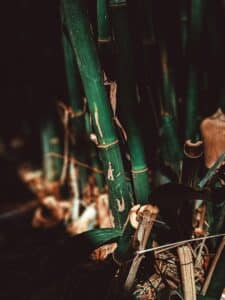Bamboo varieties in India are as diverse as the landscapes they grow in. From the misty hills of Mizoram to the dry plains of Madhya Pradesh, each region has its own kind of bamboo with a story to tell.
I still remember the first time we planted bamboo in our backyard. It was a small clump, barely two feet tall, yet within months it began shooting up like it had a secret mission.
That simple experience opened our eyes to how fast, strong and graceful this plant can be. Since then, we’ve admired not just its beauty but also its versatility — perfect for gardens, crafts, and even eco-friendly building.
“The bamboo that bends is stronger than the oak that resists.”
Introduction
Bamboo is often called the “green gold” of India. It’s one of the fastest-growing plants on Earth, known for its resilience and versatility. From traditional houses in the northeast to musical instruments in Kerala, bamboo finds a place in almost every part of Indian life.

Before we go deeper into its history and uses, let’s first get a quick overview of bamboo as a plant.
| Feature | Description |
|---|---|
| Botanical name | Bambusoideae |
| Family | Poaceae (Grass family) |
| Growth type | Woody, perennial grass |
| Height range | 1 to 40 meters depending on species |
| Lifespan | 40 to 100 years |
| Growth speed | Up to 1 meter per day for some species |
| Native range | Asia, Africa, South America |
| Main Indian states | Assam, Kerala, West Bengal, Mizoram, Madhya Pradesh |
| Soil preference | Well-drained loamy soil |
| Climate | Tropical to subtropical |
Bamboo’s strength, fast growth, and natural beauty make it one of the most sustainable plants to grow in home gardens and large landscapes.
History and Origin
Bamboo has deep roots in India’s culture and environment. The word “bamboo” is believed to come from the Dutch word bamboes, adapted from the Malay term mambu. In Sanskrit, bamboo is called vansh or bans, a word often linked with family lineage and growth — which shows how closely this plant connects with Indian tradition.
Historically, bamboo has been used in India for centuries — in homes, bridges, fences, mats, and even cooking tools. Ancient texts mention its spiritual and cultural role in ceremonies and crafts. The northeastern states, especially Assam and Mizoram, have long been centers of bamboo craftsmanship, creating everything from musical instruments to beautiful furniture.
In modern times, bamboo’s value has gone beyond culture. It’s recognized as an eco-friendly substitute for timber and plays a major role in reducing soil erosion and improving rural livelihoods.

Growing Conditions
If you’re planning to grow bamboo, the good news is that it doesn’t demand much. It adapts easily to most conditions, but the right environment can help it thrive beautifully.
Soil: Bamboo loves well-drained loamy soil enriched with organic matter. Avoid heavy clay or waterlogged areas.
Water: Regular watering is important, especially in the first year. Once established, bamboo can handle dry periods quite well.
Sunlight: Most species prefer full sunlight, but some varieties grow well in partial shade.
Temperature: Bamboo grows best in temperatures between 18°C and 35°C. In colder regions, choose hardy species that tolerate frost.
Fertilizer: Apply compost or organic manure twice a year for strong shoots and lush green growth.
Spacing: Give at least one meter between clumps to allow roots to spread freely.

Varieties of Bamboo in India
India has more than 125 species of bamboo, spread across different regions and climates. Here are ten popular varieties you can grow or admire for their unique beauty and uses.
1. Bambusa vulgaris
Description: A common bamboo with tall yellow-green culms often grown as a living hedge or ornamental plant.
Native place: Assam
Fruit name: None (rarely flowers)
Climate type: Tropical
2. Dendrocalamus strictus
Description: Known as solid bamboo, used in furniture making and paper production. Its culms are dense and strong.
Native place: Central India
Fruit name: None
Climate type: Dry tropical
3. Bambusa bambos
Description: Giant thorny bamboo used for construction, scaffolding, and fencing due to its strong culms.
Native place: Western Ghats
Fruit name: Rarely flowers
Climate type: Humid tropical
4. Bambusa balcooa
Description: Thick-walled bamboo with excellent strength, ideal for building and furniture purposes.
Native place: West Bengal
Fruit name: None
Climate type: Humid tropical
5. Melocanna baccifera
Description: Famous for producing edible fruits known as bamboo rice; often used in the northeast.
Native place: Mizoram
Fruit name: Banshful (bamboo rice)
Climate type: Subtropical

6. Thyrsostachys siamensis
Description: Upright ornamental bamboo with smooth golden culms, perfect for landscaping and borders.
Native place: Northeast India
Fruit name: None
Climate type: Tropical
7. Phyllostachys aurea
Description: Popular golden bamboo used for hedges and decorative screens; grows fast in warm regions.
Native place: Imported species (widely grown in India)
Fruit name: None
Climate type: Subtropical
8. Bambusa nutans
Description: Graceful bamboo with drooping culms that create soft shade; often planted in gardens and parks.
Native place: Kerala
Fruit name: None
Climate type: Humid
9. Bambusa tulda
Description: Straight, smooth culms used in handicrafts, baskets, and light furniture. Common in the northeast.
Native place: Assam
Fruit name: None
Climate type: Subtropical
10. Dendrocalamus giganteus
Description: One of the tallest bamboo species in the world; used in heavy construction and furniture.
Native place: Northeast India
Fruit name: None
Climate type: Humid tropical
| Variety Name | Description | Native Place |
| Bambusa vulgaris | Common bamboo with tall yellow-green culms, ideal for hedges | Assam |
| Dendrocalamus strictus | Solid bamboo used in furniture and paper | Central India |
| Bambusa bambos | Giant thorny bamboo, used in construction | Western Ghats |
| Bambusa balcooa | Thick-walled, strong bamboo perfect for building | West Bengal |
| Melocanna baccifera | Known for its sweet edible fruit called bamboo rice | Mizoram |
| Thyrsostachys siamensis | Upright, ornamental bamboo with golden stems | Northeast India |
| Phyllostachys aurea | Beautiful golden bamboo, popular in landscaping | Imported species |
| Bambusa nutans | Graceful, drooping culms, ideal for shade gardens | Kerala |
| Bambusa tulda | Commonly used for furniture and crafts | Assam |
| Dendrocalamus giganteus | World’s tallest bamboo species, used in construction | Northeast India |
Care Tips
Bamboo might look tough, but it appreciates care. With a little attention, it stays healthy and beautiful all year.
1. Watering: Young bamboo needs consistent moisture. Water twice a week in dry months. Avoid overwatering, as roots dislike soggy soil.
2. Pruning: Trim old or dead culms once a year to promote new growth and airflow within the clump.
3. Mulching: Add a layer of dried leaves or organic mulch around the base. It helps retain moisture and keeps the soil cool.
4. Fertilizing: Use compost or organic manure every six months. Avoid strong chemical fertilizers.
5. Repotting (for potted bamboo): If you grow bamboo in pots, shift it to a larger container every two years to prevent root crowding.
6. Propagation: The easiest way is through culm cuttings or rhizome divisions. Take a healthy section with two or three nodes and plant it during early monsoon.

Problems and Solutions
Even a strong plant like bamboo can face a few challenges. Here are common problems and how to solve them.
Problem: Yellowing leaves
Cause: Overwatering or nutrient deficiency
Solution: Reduce watering and feed compost. Remove affected leaves.
Problem: Pests like aphids or mealybugs
Cause: Warm humid weather
Solution: Spray neem oil or soap water once a week until pests are gone.
Problem: Weak shoots or poor growth
Cause: Lack of sunlight or overcrowding
Solution: Thin out older culms and move plants to a brighter location.
Problem: Root rot
Cause: Standing water in soil
Solution: Improve drainage and replant in raised beds.
Problem: Flowering and dieback
Cause: Natural aging (some species die after flowering)
Solution: Replace the clump with new cuttings from healthy plants.
Uses and Benefits
Bamboo is more than just a plant — it’s a part of India’s everyday life.
1. Ornamental: Gardeners love bamboo for its elegant look. It makes great privacy screens, windbreaks, and natural fences.
2. Construction: The strong culms of species like Dendrocalamus strictus are used in scaffolding, flooring, and furniture.
3. Environmental: Bamboo absorbs carbon dioxide faster than most trees and releases 35% more oxygen. It helps prevent soil erosion and restores degraded land.
4. Medicinal: Some species are used in traditional medicine to treat infections and improve digestion.
5. Cultural: In many Indian regions, bamboo symbolizes strength, prosperity, and flexibility. It’s often used in weddings and festivals.
6. Culinary: Tender bamboo shoots are used in northeastern dishes. The fruit of Melocanna baccifera, called bamboo rice, is considered nutritious.
7. Economic: Bamboo farming is a growing business in India, providing raw material for handicrafts, furniture, and paper industries.

Interesting Facts
- Bamboo is technically a grass, not a tree.
- Some species can grow up to 90 cm in a single day.
- Bamboo flowering is a rare event that may occur once every 50 to 100 years.
- India is the second-largest bamboo-growing country in the world after China.
- The northeast region holds more than 60% of India’s bamboo resources.
FAQs
1. Can I grow bamboo in pots?
Yes, you can. Choose compact or clumping species like Bambusa multiplex. Use a large container with drainage holes and rich soil. Water regularly and prune old shoots. Potted bamboo grows well on balconies or patios when given enough sunlight and space.
2. How do I stop bamboo from spreading too much?
Running bamboo species spread fast through underground rhizomes. To control them, install a root barrier around the planting area or grow them in large containers. Regular pruning of side shoots also helps maintain shape and size.
3. Is bamboo good for the environment?
Absolutely. Bamboo is one of the most sustainable plants on Earth. It absorbs carbon dioxide, stabilizes soil, and grows quickly without the need for pesticides. It’s an eco-friendly substitute for timber in many industries.
4. Which bamboo variety is best for Indian home gardens?
For home gardens, clumping species like Bambusa vulgaris, Bambusa nutans, or Phyllostachys aurea are perfect. They’re attractive, easy to maintain, and don’t invade nearby spaces. Choose one based on your climate and available space.
5. Does bamboo attract pests or snakes?
Bamboo itself doesn’t attract snakes or pests, but dense growth may offer shelter to small animals. Keep your clumps trimmed and clean. Use neem oil spray occasionally to prevent insects. A well-maintained bamboo garden stays safe and healthy.
Conclusion
Bamboo is a plant of balance — strong yet flexible, fast-growing yet gentle on the earth. From eco-friendly construction to peaceful home gardens, its uses are endless. Growing bamboo connects us with nature’s simplicity while offering a touch of green elegance to any space.
Whether you plant it for its beauty, utility, or symbolism, bamboo always rewards patience and care. Start with a small clump and watch it transform your space into a green haven.
Thanks for reading. Keep growing, keep exploring, and don’t forget to return here at gardeningbud.com for more plants, tips and gardening wisdom.
